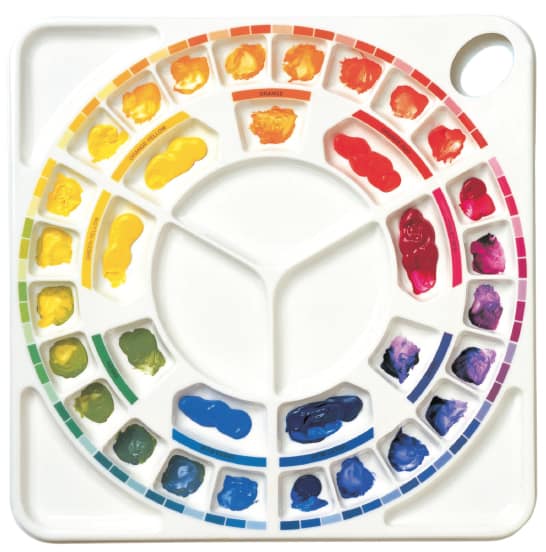
The schemes of nature are usually quite simple. In this example, violet-red plus green, together with their mixes and influence from the light provide the full picture. This simplicity can be adopted when it comes to the selection of the paints to employ. If any additional colours are required, they should, perhaps, be kept to a minimum.
Violet-red (from the flower-blue) colorings appears in the flower, the stems and around each immature berry.
The presence of chlorophyll modifies this redness, giving the range from the unmixed hue of the flower to the dulled violet-red of the stems and onto the brown around the fruit.
Many a painter would select 4-5 different colours to depict this range plus a further 3-4 greens to use when painting the leaves and darker background.

Quinacridone Violet and Mixed Greens
When depicting such colours in a painting, the mixes provided by violet-red and a mixed green will give most of the required hues.
Quinacridone Violet and Phthalocyanine Green

The darks in the background can be added by mixing a little Phthalocyanine Green (or Viridian) with the same violet-red. When kept deliberately simple, harmony is available.
The range provided by just two colours, particularly if they are mixing complementaries, can be more than sufficient for many a piece of work, or a passage within that work.
If any additional colours are required they should be chosen with care and for sound reasons. Not just because they happen to be left over on the palette!
 Autumn Leaves Example
Autumn Leaves Example
When leaves are damaged or the stems become loose, (as in the Autumn/Fall) the green Chlorophyll is restricted in movement. This triggers off certain chemical changes which lead to the yellows, oranges, reds and violets as shown above. The changes also lead to the amazing free colour show provided in the Autumn (Fall) in many countries.
When depicting such colours in a painting, it will aid colour harmony if the yellow used to paint the yellowing leaves is the same as that used when mixing the greens.
If the yellow of the damaged leaves leans towards orange, it will help if the greens are mixed from the same orange-yellow.
If the red-violet shown above in the leaf to the right, is also used in the stems we have another close relationship.
A further aid to harmony comes about as the yellow and violet are visual complementaries. This factor can be emphasised in a painting. Perhaps by touches of a slightly brighter violet, or the conversion of a few green leaves into yellows and violet.
Two colours can be enough for an entire painting, or certainly for passages within a painting. Three colours and we have a very wide range at our disposal. Four hues will give an enormous array to work with.
Five-six or more and most painters have lost control of colour harmony almost before commencing the work.
A restricted palette, used with thought and a little skill, offers the best opportunity for colour beauty. If you need help with colour mixing, let us know.

